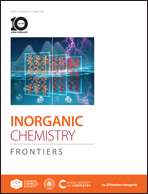A unique [Sb6O2S13]12− finite chain in oxychalcogenide Ba6Sb6O2S13 leading to ultra-low thermal conductivity and giant birefringence†
Abstract
Recently, heteroanionic materials have been drawing wide attention due to their unique crystal structures which result in fascinating physical properties. However, reports on structural exploration and functional application of lone-pair-cation-based oxychalcogenides are still very rare. In this work, a new Sb-based oxysulfide, Ba6Sb6O2S13, was successfully obtained via a high-temperature solid-phase method. Ba6Sb6O2S13 belongs to the monoclinic space group of P21/c (no. 14) and is formed by charge-balanced Ba2+ cations and zero-dimensional (0D) [Sb6O2S13]12− finite chains made of the triangular-pyramid [SbOS2], quadrangular-pyramid [SbOS3] and teeter-totter [SbS4] units by sharing vertices. Note that the coexistence of various Sb-coordinated fashions in one material is surprisingly found for the first time. More encouragingly, such a unique 0D structure in Ba6Sb6O2S13 leads to an ultra-low thermal conductivity of 0.25 W m−1 K−1 at 700 K (one of the lowest values seen in a crystalline material) and a giant birefringence of 0.66 at 2050 nm (the highest value among metal chalcogenides reported thus far), which is further confirmed using theoretical calculations. As a result, this work will inspire intriguing and further research on heteroanionic materials with low-dimensional structures and hold great potential for their utilization in the photothermal field.
![Graphical abstract: A unique [Sb6O2S13]12− finite chain in oxychalcogenide Ba6Sb6O2S13 leading to ultra-low thermal conductivity and giant birefringence](/en/Image/Get?imageInfo.ImageType=GA&imageInfo.ImageIdentifier.ManuscriptID=D3QI00850A&imageInfo.ImageIdentifier.Year=2023)
- This article is part of the themed collections: FOCUS: Nonlinear Optical Materials and 2023 Inorganic Chemistry Frontiers HOT articles


 Please wait while we load your content...
Please wait while we load your content...